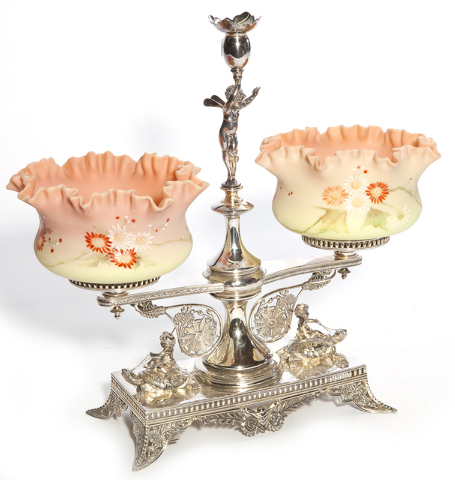Outdated serving piece fetches more than $3,000
Some serving pieces used in the 19th century are no longer needed or made. Victorian table settings were very elaborate — lace or other fancy cloths, at least six or seven special dishes for every course, like a service plate, then fish, soup, dinner, salad and butter plate, and a sauce dish.
And of course there was silverware to match each course. The minimum was about eight pieces — usually a fork, fish fork, salad fork, dessert fork, spoon, soup spoon, dinner spoon, knife and butter knife. Each type of dessert also required special dishes and serving pieces.
A berry bowl set for a dinner sold at Early’s Auction in Milford, Ohio, in April 2014 for $3,220. It was a Pairpoint silver-plated stand with boys riding on turtles and a candlestick held by a cupid.
Added to this were two crimped, pink-shaded-to-yellow Mt. Washington Burmese glass berry bowls decorated with enameled daisies. The top of the candlestick was 49 inches high, so with a candle it was an elaborate tower that had to be noticed.
Of course, the berries were served with cream from a pitcher and eaten with special berry spoons.
Q: I bought a mahogany bachelor’s chest with four drawers and a pullout shelf at an estate sale. It was made by Biggs Furniture of Richmond, Va. Does it have any value as an antique?
A: Biggs made high-quality Colonial reproduction furniture. The company was started by J.F. Biggs, who began selling antiques in Richmond in 1890. A 1912 ad claimed the antiques shop was Virginia’s largest dealer of “old mahogany furniture, old brass, cut glass, copper plate, old china, engravings, paintings, etc.”
The company began making high-end reproduction furniture when the supply of antique furniture dwindled.
In 1969 it became part of General Interiors Corp., which also owned Kittinger. It was listed as a division of Kittinger in 1975. Biggs was out of business by 2010. The value of your chest is about $500.
Q: I have a silver-plated creamer with a hinged lid marked “Albert Pick Co. Inc.” The silver plate is quite worn. Is it worth anything?
A: Albert Pick, an immigrant from Austria, founded Albert Pick Co. in Chicago in 1857. The company bought E.H.H. Smith Silver Co. of Bridgeport, Conn., in 1919 and incorporated as Albert Pick &Co. Your silver-plated creamer was made after that.
In the 1920s, family members established the Pick Hotel Corp., which operated a chain of hotels until the 1960s. They used tablewares made by Albert Pick, sometimes with the hotel name on the side. Albert Pick creamers have sold recently for $14-$22.
Q: I still have a Disney charm bracelet that was given to me in 1945 or ’46. It’s 6 inches long and has five charms — Donald Duck, Huey, Dewey, Louie and Jose Carioca. Please help me figure out what it’s worth.
A: Walt Disney introduced Donald Duck in 1934, his three nephews in 1937 and Jose Carioca, a cigar-smoking Brazilian parrot, in “Saludos Amigos,” a 1942 Disney animated feature. Jose showed up again in “The Three Caballeros” in 1944.
Several kinds of Disney character figural charms were made in the 1940s. You don’t tell us if your charms are plastic or metal. And if they’re metal, whether they’re silver, gold, filled or enameled.
A bracelet like yours with plastic charms would sell for under $50. A sterling-silver bracelet with silver or enameled charms would sell for more, and so would characters from Disney’s more popular films.
Q: When I was tearing down an old building 50 years ago, I found a poster picturing Jack Dempsey. It’s a headshot and he’s wearing a suit and tie. His signature is across his left shoulder, but it doesn’t look like a real autograph. I remember seeing the same poster, framed, at Jack Dempsey’s Restaurant on Broadway in New York City. Do you think it’s worth anything?
A: Jack Dempsey (1895-1983), one of America’s most famous boxers, was world heavyweight champion from 1919 to 1926. His restaurant on Broadway was a popular nightspot from the time it opened in 1938 until it closed in 1974. Assuming your poster was not signed by Dempsey, it would sell for under $10.
Q: I’ve been collecting Sebastian Miniatures since the 1940s. Is the company still in business? I’d like to sell my collection. Are there any certified appraisers of Sebastian Miniatures?
A: Sebastian Miniatures were first made by Prescott W. Baston (1909-1984) in 1938. At first he worked out of his basement in Arlington, Mass. In 1946, he moved his studio to Marblehead, Mass.
From 1946 to 1976, Sebastian Miniatures were made in Hudson, Mass., in cooperation with Lance Corp. Lance closed in 1976. Baston’s son, Prescott W. Baston Jr., began designing figurines in the 1980s.
Sebastian Miniatures have been made by Wayland Studio in Wayland, Mass., since 1998. More than 400 different designs have been made, and collectors search for the out-of-production models. Most sell online for under $10, but some early figures sell for much more. Some appraisers are listed on www.sebastianworld.com/services/appraisals/index.htm.
Tip: Never use chlorine bleach on ironstone dishes. It will cause the glaze to flake off.
Terry &Kim Kovel’s column is syndicated by King Features. Write to: Kovels, (Las Vegas Review-Journal), King Features Syndicate, 300 W. 57th St., New York, NY 10019.

















